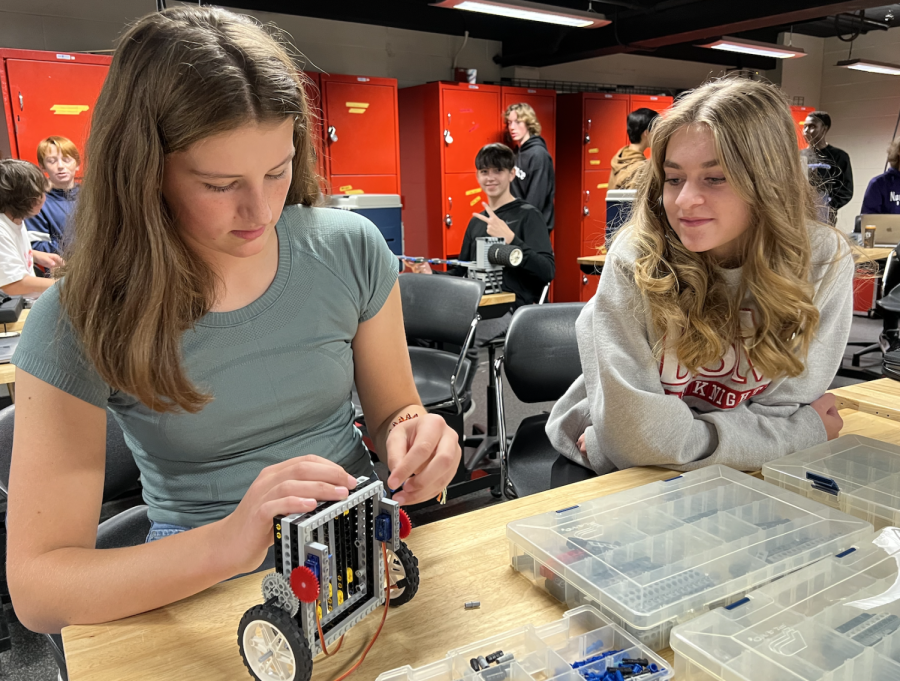The BSM Engineering department, at its core, resembles male dominance
Two out of the three girls in 6th period Engineering working on a project while surrounded by boys at all angles.
As the difficulty level of Engineering increases, gender discrepancies widen synchronously, leaving only a few girls left in upper level Engineering classes at BSM. The male to female ratio is pretty balanced in Engineering I and II, but come Engineering levels III and IV, almost no girls remain in the program.
BSM’s Engineering program is one thing that sets it apart from similar schools around the Twin Cities. Located in the basement, the Engineering room is designed to ignite collaboration within a few different work spaces––the salon, the typical “classroom” portion, and a back work area where materials are often stored.
While most students dive into Engineering via Engineering I, which takes place during either the first or second semester of the school year, BSM also offers summer Engineering programs for levels I, II, and III. These summer programs give students the chance to take advantage of an academic field that maybe didn’t fit into their schedule during the school year, or that they may just be interested in discovering/learning more about. “I started engineering the summer after my freshman year and have been in it ever since,” senior Nicole Doering, who is now in Engineering IV, said.
The engineering courses at BSM are unlike any other class offering. For better or worse, they are built upon solving real-world problems through collaborative solutions. For students who thrive in collaboration, the class is often a good match, and for students who prefer working alone, many can witness, firsthand, the benefits of having a team alongside you while solving complex challenges with creative solutions. “I like the class environment because it is different from all my other classes. It feels more like the real world and it challenges my creativity in a way that other classes don’t,” Doering said.
I like the class environment because it is different from all my other classes. It feels more like the real world and it challenges my creativity in a way that other classes don’t
— Doering
Another aspect of the Engineering classes that separate them from any other class, or department, is the high and far-reaching level of freedom given to students within the department. Students are encouraged to make atypical discoveries, strive for unexpected solutions, and above all, use their teachers and innovative work space as a means of growth, not means of restriction. All these factors combined often help and encourage girls in the Engineering program to stick with it beyond Engineering one and two. “The collaboration and the freedom we have in the class has motivated me to keep going,” senior Gebby Simpson, an Engineering III student, said.
But with everything positive that the Engineering department offers, there is a constant discrepancy always lingering in the background: the lack of girls that remain in the program after years one and two. Last year, Suzy Haakonson, who is now a senior in the RED Capstone Engineering class, conducted research framed around the central goal of finding one or more reason(s) as to why there is a substantial difference between the number of male and female students enrolled in the BSM Engineering Department.
In her research, Haakonson found that during the 2019-2020 school year, the BSM Engineering Department was 75% male (695 students) and only 25% female (235 students). Since then, similar numbers have been retained, allowing the gender discrepancy to continue. “I have definitely seen many girls feel disadvantaged because so many of the other guys come in with a feeling of knowing exactly what they want to do, ‘I’m going to do coding, I’m going to do 3D printing, I’m going to communicate’, and the girls come in with a different set of opinions and the mindset of ‘Maybe this is what I want to do,’” Haakonson said.
But BSM isn’t to blame for this imbalance; it’s just an unfortunate side effect of engineering systems worldwide. Engineering Department Chair Anne Dougherty has no shortage of this experience herself. In her twenties, Dougherty founded a technology startup in the financial services industry, which similar to Engineering, is a very male dominated field. “I often found myself at trade shows and during traveling as the only woman in the room or at a table,” Dougherty said.
That’s problematic when students go to college and take really hard Engineering classes, and girls who typically have been A-students are now getting B’s, or dreaded C’s, and they think ‘I’m not cut out for this’, whereas their male counterparts are getting C’s and think they’re great, so that discourages women from carrying on because they don’t have the sense that they’re exceptional
— Dougherty
Dougherty has found that during her time teaching Engineering at BSM, girls in the Engineering program have struggled with the concept of mastery, which not only rattles their confidence, but prohibits them from advancing deeper into the department. “For a woman to consider herself good at something, she has to be an expert…so before you’re willing to say out loud ‘Gosh I’m really good at that’ you have to be exceptional at it, whereas you see with men they are much more likely to say ‘I’m good at that’ even if they’re not at a mastery level,” Dougherty said.
This toxicity surrounding mastery can become a breaking point at the high school level and college level for women in engineering. “That’s problematic when students go to college and take really hard Engineering classes, and girls who typically have been A-students are now getting B’s, or dreaded C’s, and they think ‘I’m not cut out for this’, whereas their male counterparts are getting C’s and think they’re great, so that discourages women from carrying on because they don’t have the sense that they’re exceptional,” Dougherty said.
Despite this, girls in the Engineering Department at BSM in upper levels, for the most part, feel as if they’re treated equitably by their teachers and by the majority of their male counterparts. The opportunities girls and boys in the department are presented with are homogenous, but still a male-dominant stereotype lingers in the atmosphere. “I think that we are given the same amount of attention and advantages in class, but I think that we have to maybe step out of our way a bit to show that we understand too,” Simpson said.
I think that we are given the same amount of attention and advantages in class, but I think that we have to maybe step out of our way a bit to show that we understand too
— Simpson
Beyond BSM, Doering, Haakonson, and Simpson all plan to pursue Engineering in different capacities. Haakonson, in particular, is interested in studying Business and Business Management, and has learned leadership and listening skills through Engineering that can aid her in the future. At the root of it, Engineering has taught all three girls the importance of finding solutions to real-world problems––and it’s the non-linear process of getting to the solution that truly builds a strong Engineer. “I know Engineering seems very much like it’s all coding or all 3D printing, but a lot of the class is actually teaching you how to fail,” Haakonson said.

















































